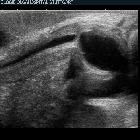fetal megacystis

Fetal
megacystis • Intrauterine fetal demise and megacystis - Ganzer Fall bei Radiopaedia

Fetal
megacystis • Fetal megacystis - Ganzer Fall bei Radiopaedia

Fetal
megacystis • Echogenic fetal kidneys and megacystis - Ganzer Fall bei Radiopaedia

Fetal megacystis refers to the presence of an unusually large bladder in a fetus.
Epidemiology
The estimated incidence of antenatal imaging is at ~1:1500 pregnancies.
Pathology
It can result from a number of causes but the main underlying mechanism is either distal stenosis or reflux.
Associations
Associated anomalies are common and include:
- posterior urethral valves
- chromosomal anomalies
- on a first trimester scan (10-14 weeks)
- if the longitudinal bladder diameter is 7-15 mm, the risk of chromosomal defects is estimated at ~25%
- if the bladder diameter is >15 mm, the risk of chromosomal defects is estimated at ~10%
- on a first trimester scan (10-14 weeks)
- oligohydramnios
- megacystis microcolon intestinal hypoperistalsis (MMIH) syndrome (Berdon syndrome)
- megacystis megaureter syndrome
- prune belly syndrome
Radiographic assessment
Antenatal ultrasound
It is generally defined as:
- bladder diameter >7 mm in the first trimester
- bladder diameter >30 mm in the second trimester
- bladder diameter >60 mm in the third trimester
Ancillary sonographic findings
- may show evidence of oligohydramnios
- may show associated renal anomalies
Treatment and prognosis
The overall prognosis can be variable from progressive obstruction to spontaneous resolution. A follow-up ultrasound is necessary to correctly interpret the significance of megacystis detected in the first trimester.
If the fetus is chromosomally normal and there is megacystis on the 1 trimester scan:
- there is a spontaneous resolution of the megacystis in about 90% of cases when the 1 trimester longitudinal bladder diameter is between 7-15 mm
- if the bladder diameter is >15 mm, there is a very high likelihood of progressive obstructive uropathy
Management will depend on the underlying pathology.
Siehe auch:
- Oligohydramnion
- prune belly syndrome
- Urethralklappe
- chromosomale Anomalien
- fetale intraabdominelle Zysten
- megacystis microcolon intenstinal hypoperistalsis syndrome
- renal anomalies
- megacystis megaureter syndrome
und weiter:

 Assoziationen und Differentialdiagnosen zu fetale Megazystis:
Assoziationen und Differentialdiagnosen zu fetale Megazystis:



